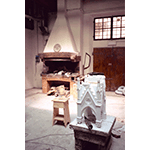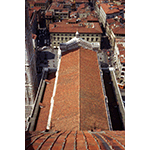Cathedral of Santa Maria del Fiore
The Cathedral of Santa Maria del Fiore was founded in 1296 on the site of the early Christian basilica of Santa Reparata. Construction began from the facade, probably on a project by Florentine architect Arnolfo di Cambio, and lasted for approximately two centuries (the facade was completed, however, only at the end of the 19th century). Always considered a temple of art, as well as a place of worship, the Cathedral also preserves important evidence that refers to the world of science.
In 1475, mathematician Paolo dal Pozzo Toscanelli built a gnomon, the highest ever built in a church and the oldest that has come down to us, which makes it possible to check the moment of the Sun’s passage into the summer solstice. A bronze tablet, called bronzina, bearing the gnomonic hole was placed at the base of the cupola’s lantern. In the period between May and July, the sun’s rays filter through this hole and give rise to an image of the Sun about 90 metres below, on the floor of the Cappella della Croce, where the Renaissance solstice signs are found, along with the meridian altitude installed in 1755 by Jesuit Leonardo Ximenes.
The clock by Paolo Uccello on the counter facade ideally certifies the passage from the Sun’s motion to the mechanical reckoning of the passing of time. Formed by a circle inscribed in a square, it is divided into 24 sectors corresponding to the hours, in Roman numerals. A peculiar feature of this clock is the arrangement of the hours counter clockwise, starting from below, in accordance with a practise derived from sundials.
In the left aisle, beside one of the side entrances, a fifteenth-century painting by Domenico di Michelino portrays Dante and the Divine Comedy. On the observer’s left is Hell; in the background, the mountain of Purgatory surrounded by water, and on the right Jerusalem, depicted as Florence. The painting offers an interesting image of the concept of the cosmos in the Middle Ages. Around the Earth revolve the celestial spheres, represented by stripes of different shades of azure, which in the Aristotelian concept correspond to the seats of the then known planets, while the last sphere is that of the fixed stars. In the Dantean universe, there are ten skies: the last is the Empyrean, the eternal seat of God and of the Blessed. It is curious to note how in the painting that portrays Dante and the Divine Comedy, the number of skies does not correspond to the one proposed by the poet, but instead to the one most widespread in Medieval cosmology. In any case, this is an important illustrated document of a concept of the universe that would be disputed by the Copernican system and by Galileo’s astronomical discoveries.
The bust of the Pisan scientist by Adolfo Calducci is outside on the monumental facade. It can be observed in the lower left corner of the cornice that frames the middle rose window. Close to the bust is a telescope, one of the symbolic instruments of the astronomical revolution. Around this same rose window, one can also admire the ideal portraits of Marsilius Ficinus, Paolo dal Pozzo Toscanelli, Amerigo Vespucci, also by Calducci, and those of Pippo Spano and Niccolò Acciaiuoli, attributed to Passaglia.
The scientific itinerary of this extraordinary artistic complex continues in the Dome, Giotto’s Bell Tower, in the Baptistery and in the Museo dell’Opera del Duomo.
****************************
Texts by Graziano Magrini
English translation by Victor Beard
Last update 22/feb/2008





